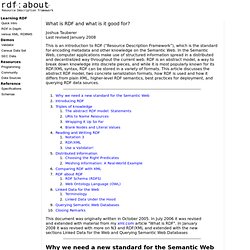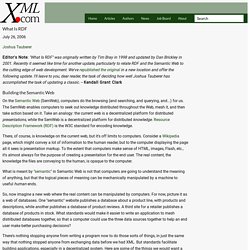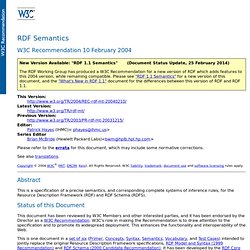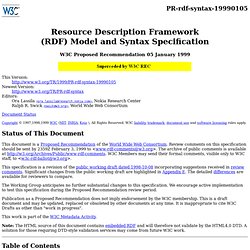Resource Description Framework (RDF)
> Flaviatovo
> At work
> Developer
> AI
> Data Mining
Context and Target Configurations for Mining RDF Data. Querying RDF Data from a Graph Database Perspective. Semantic Graph Mining for e-Science. Quick Intro. Quick Intro to RDF This is a really brief introduction to Resource Description Framework (RDF). You might also be interested in... For a more detailed look at RDF, see RDF in Depth on this site, which this page was based on. Two video introductions to the Semantic Web and RDF and RDFa by Manu Sporny are very good.
Ian Davis's RDF Tutorial slides are also very good. RDF is a method for expressing knowledge in a decentralized world and is the foundation of the Semantic Web, in which computer applications make use of distributed, structured information spread throughout the Web. The Big Picture RDF is a general method to decompose any type of knowledge into small pieces, with some rules about the semantics, or meaning, of those pieces.
@prefix : < . The meaning is obvious. If you know XML, here's a brief comparison. But you don't have to use XML.
What is it and what is it good for?
What is RDF and what is it good for?

Why we need a new standard for the Semantic Web On the Semantic Web, computers do the browsing for us. The “SemWeb” enables computers to seek out knowledge distributed throughout the Web, mesh it, and then take action based on it. To use an analogy, the current Web is a decentralized platform for distributed presentations while the SemWeb is a decentralized platform for distributed knowledge. RDF is the W3C standard for encoding knowledge. There of course is knowledge on the current Web, but it's off limits to computers. What is meant by “semantic” in the Semantic Web is not that computers are going to understand the meaning of anything, but that the logical pieces of meaning can be mechanically manipulated by a machine to useful ends. So now imagine a new Web where the real content can be manipulated by computers. 1. Knowledge as a Graph Whether we represent the graph as a picture or in a table, we're talking about the same thing.
What Is it. What Is RDF July 26, 2006 Joshua Tauberer Editor's Note: "What Is RDF" was originally written by Tim Bray in 1998 and updated by Dan Brickley in 2001.

Recently it seemed like time for another update, particularly to relate RDF and the Semantic Web to the cutting edge of web development. We've republished the original in a new location and offer the following update. Building the Semantic Web On the Semantic Web (SemWeb), computers do the browsing (and searching, and querying, and...) for us. There, of course, is knowledge on the current web, but it's off limits to computers.
What is meant by "semantic" in Semantic Web is not that computers are going to understand the meaning of anything, but that the logical pieces of meaning can be mechanically manipulated by a machine to useful human ends. So, now imagine a new web where the real content can be manipulated by computers. 1. Figure 1. Each row of the table specifies an edge from one node in the graph to another.
Semantics. W3C Recommendation 10 February 2004 New Version Available: "RDF 1.1 Semantics" (Document Status Update, 25 February 2014) The RDF Working Group has produced a W3C Recommendation for a new version of RDF which adds features to this 2004 version, while remaining compatible.

Tutorial. Model and Syntax Specification. PR-rdf-syntax-19990105 W3C Proposed Recommendation 05 January 1999 This Version: Newest Version: Editors: Ora Lassila <ora.lassila@research.nokia.com>, Nokia Research Center Ralph R.

Document Status Copyright © 1997,1998,1999 W3C (MIT, INRIA, Keio ), All Rights Reserved. Status of This Document This document is a Proposed Recommendation of the World Wide Web Consortium. This specification is a revision of the public working draft dated 1998-10-08 incorporating suggestions received in review comments. The Working Group anticipates no further substantial changes to this specification.
Publication as a Proposed Recommendation does not imply endorsement by the W3C membership.
Wikipedia. The Resource Description Framework (RDF) is a family of World Wide Web Consortium (W3C) specifications[1] originally designed as a metadata data model.

It has come to be used as a general method for conceptual description or modeling of information that is implemented in web resources, using a variety of syntax notations and data serialization formats.





